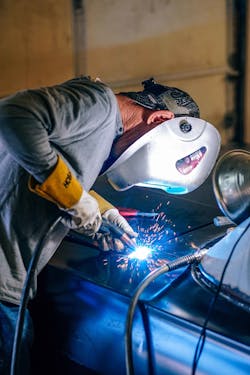If you work in collision repair long enough, you’re bound, unfortunately, to run into a vehicle with low quality previous work. Rodney Snell, manager of Beachcliff Body Repair in Miami, says his shop recently encountered such an issue with a 2014 Honda Accord. “It was a bad front-end hit. After we went to do a tear down for the blueprinting, we found all kinds of damage that didn’t jibe with the accident,” he says. “My guys did a little investigating and found that the car had been t-boned before and nearly every single weld from that repair looked like they had been blown apart.” When the additional damage was tallied, it pushed the vehicle into total loss territory, costing the owner a vehicle, the insurer an expensive payoff and Snell’s business much needed work.
Worse still, the poor repair was performed for a previous owner who couldn’t be located, by a shop that couldn’t be identified. No legal recourse existed, and the current owner was left to cash an insurance check that fell short of the vehicle loan payoff.
Incidents like this give a black eye to the entire collision repair industry. Snell has seen bad work before but says this incident sticks out because, aside from the welds, the rest of the old repair appeared up to standard. Essentially, the work of a single worker caused a serious problem for every party involved in the later accident. The lesson here for the entire repair industry is that problems like these can be easily avoided when welders do the right thing and churn out a good repair. Help make sure your welders consistently create safe, industry standard welds using the following tips submitted by I-CAR’s team of technical experts.
Tip 1: Always address the basics of proper welding. Always! That means avoiding these common mistakes:
· Getting comfortable in relying on their years of experience such as sound of the arc and what the weld looks like, vs. performing test welds and proper destructive testing to ensure the weld is of sound quality.
· Not referencing vehicle maker service information to determine whether welding is permitted or not looking into other critical or related issues such as the strength of the steel. Your staff always should refer to the OEM instructions no matter how confident they feel about a repair.
· Not using proper ventilation equipment or Personal Protective Equipment (PPE). Workers who aren’t working safely aren’t performing quality work.
· Not protecting the vehicle. No sparks should be striking the vehicle, and welders need to prevent any electrical issues by disconnecting the battery and removing modules and wiring from the weld zone.
· Not cleaning the metal, especially e-coat, which can result in the weld burning it off and contaminating the weld.
· Using a welder that needs maintenance and not performing properly.
Tip 2: Develop your new welders the “right” way. The punchline to the old joke “How do you get to Carnegie Hall?” is “practice.” The best advice for new welders or anyone practicing this craft is the same, only tripled – practice, practice, practice.
The usual process for learning to weld starts with covering the basics, followed by picking up foundational skills and then growing them. With enough time and practice, the new welder becomes proficient, and the work becomes “second nature” (like riding a bike). However, the learning process shouldn’t stop there. I-CAR says these new skills regularly need to be honed and freshened up, which can only be accomplished through practice. Moreover, I-CAR says welders shouldn’t restrict practicing to skills they’ve already acquired. They need to build on their learning and practice new techniques and practice with different types of equipment.
Practice should involve performing destructive weld tests. It additionally should incorporate reviewing welding equipment manufacturer manuals for voltage, breaker, and wiring requirements. (If welding equipment is not receiving the proper voltage or current, it won’t generate the correct voltage for the weld.)
Finally, I-CAR recommends developing and following a welding SOP that includes directions for performing a quick equipment inspection, checking service information, properly protecting the vehicle, and performing the test welds and destructive tests.
Tip 3: Train often, regardless of a welder’s experience. I-CAR recommends training as often as possible.
While frequent training in practically every other area of collision repair is a common recommendation, it’s particularly important with welding since I-CAR says the average tech welds once a week and can sometimes go weeks at a time without touching a welder. Unused or underused skills can degrade over time. Techs who weld every week are more likely to keep their skills up to par. Techs who only occasionally weld need to train often so they aren’t having to re-learn how to weld every time they need to do so.
Formal in-person training is preferred and should be taken every 2-3 years; in between these times, I-CAR suggests turning to online courses and studying technical articles to refine skills.
I-CAR also suggests looking into auto manufacturer recommendations. For example, Audi recommends formal training every two years for aluminum and five years for steel. Note here that I-CAR educators prefer more frequent training intervals.
Tip 4: Learn how to weld on EVs. Working on EVs is a potentially deadly proposition if you don’t stick strictly to OEM procedures.
Take steps such as disarming high voltage and 12V battery systems, pull back wiring and electrical components. Refer to vehicle maker instructions for checking voltage and SOPS for safeguarding a vehicle from accidental arming of the high voltage system, which is crucial.
Tip 5: Leverage available welding technology
Keep your equipment selection up to date to ensure you can handle every necessary type of weld in a repair and maintain the quality of the work as well.
MIG Brazing is becoming more common in U.S collision repair. I-CAR recommends technicians review vehicle service information to identify MIG Braze requirements and receive proper training to be qualified to perform this type of welding.
If you’re going to weld aluminum, you’ll need to create a separate space, “clean room” for this work to prevent cross contamination.
Tip 6: Take proper care of your welding tools. Welding equipment can be very expensive. Properly maintaining it will not only help preserve your investment.
When maintenance requirements are identified they should be handled immediately, trying to get by with a welder that is not performing correctly will commonly result in poor quality welds and further damage to the welder. Maintaining it not only preserves your investment, but the maintenance shows up in the work quality as well. Welding equipment that doesn’t operate optimally won’t provide the level of work you need to deliver.
Caring for this equipment involves regular professional inspection by someone who is qualified by that equipment manufacturer.
Along with the inspections, a welder set-up with a start-up checklist should be posted on each welder. Common consumable materials and PPE should be readily available and accessible. Finally, cover your equipment when it isn’t in use to protect it.
Odds are your welding experience and training have made you aware of many of these tips. A lot of what you’ve just read may fall in the category of common sense. The problem with common sense is that it stops being common when shops don’t take the steps to ensure it’s put to work every day and in every task they perform.
As Snell’s example shows, this work affects not only your current customer, it touches every subsequent owner and the vehicle’s occupants. That’s a lot of responsibility for any business to assume. But you’re more than capable of doing just that when you take the time to ensure you’re doing your best work every time. That’s how your business and customers stay well.





